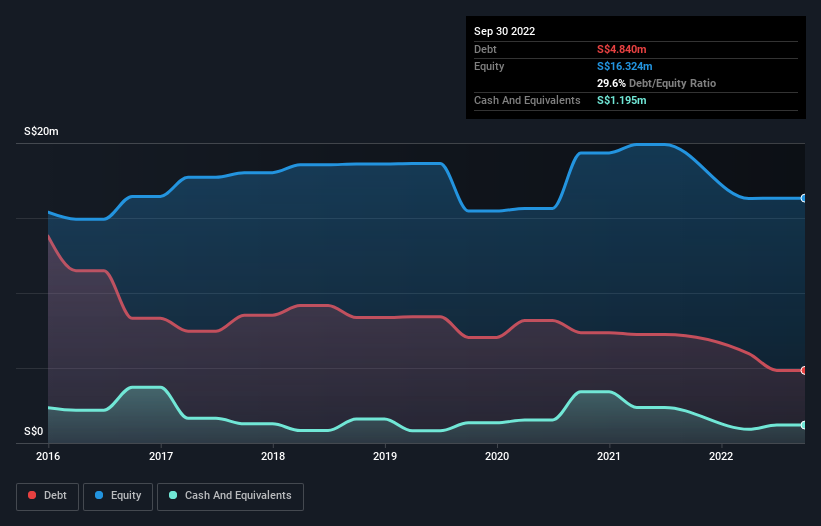
Howard Marks put it nicely when he said that, rather than worrying about share price volatility, 'The possibility of permanent loss is the risk I worry about... and every practical investor I know worries about.' So it seems the smart money knows that debt - which is usually involved in bankruptcies - is a very important factor, when you assess how risky a company is. Importantly, VibroPower Corporation Limited (SGX:BJD) does carry debt. But is this debt a concern to shareholders?
What Risk Does Debt Bring?
Debt assists a business until the business has trouble paying it off, either with new capital or with free cash flow. Part and parcel of capitalism is the process of 'creative destruction' where failed businesses are mercilessly liquidated by their bankers. However, a more common (but still painful) scenario is that it has to raise new equity capital at a low price, thus permanently diluting shareholders. Of course, plenty of companies use debt to fund growth, without any negative consequences. When we examine debt levels, we first consider both cash and debt levels, together.
View our latest analysis for VibroPower
What Is VibroPower's Net Debt?
You can click the graphic below for the historical numbers, but it shows that VibroPower had S$4.84m of debt in September 2022, down from S$7.24m, one year before. However, it also had S$1.20m in cash, and so its net debt is S$3.65m.

A Look At VibroPower's Liabilities
According to the last reported balance sheet, VibroPower had liabilities of S$8.11m due within 12 months, and liabilities of S$3.64m due beyond 12 months. On the other hand, it had cash of S$1.20m and S$12.6m worth of receivables due within a year. So it actually has S$2.03m more liquid assets than total liabilities.
This surplus liquidity suggests that VibroPower's balance sheet could take a hit just as well as Homer Simpson's head can take a punch. Having regard to this fact, we think its balance sheet is as strong as an ox. The balance sheet is clearly the area to focus on when you are analysing debt. But it is VibroPower's earnings that will influence how the balance sheet holds up in the future. So if you're keen to discover more about its earnings, it might be worth checking out this graph of its long term earnings trend.
In the last year VibroPower had a loss before interest and tax, and actually shrunk its revenue by 7.2%, to S$14m. We would much prefer see growth.
Caveat Emptor
Over the last twelve months VibroPower produced an earnings before interest and tax (EBIT) loss. Indeed, it lost a very considerable S$684k at the EBIT level. That said, we're impressed with the strong balance sheet liquidity. That will give the company some time and space to grow and develop its business as need be. While the stock is probably a bit risky, there may be an opportunity if the business itself improves, allowing the company to stage a recovery. There's no doubt that we learn most about debt from the balance sheet. But ultimately, every company can contain risks that exist outside of the balance sheet. To that end, you should be aware of the 3 warning signs we've spotted with VibroPower .
At the end of the day, it's often better to focus on companies that are free from net debt. You can access our special list of such companies (all with a track record of profit growth). It's free.
New: Manage All Your Stock Portfolios in One Place
We've created the ultimate portfolio companion for stock investors, and it's free.
• Connect an unlimited number of Portfolios and see your total in one currency
• Be alerted to new Warning Signs or Risks via email or mobile
• Track the Fair Value of your stocks
Have feedback on this article? Concerned about the content? Get in touch with us directly. Alternatively, email editorial-team (at) simplywallst.com.
This article by Simply Wall St is general in nature. We provide commentary based on historical data and analyst forecasts only using an unbiased methodology and our articles are not intended to be financial advice. It does not constitute a recommendation to buy or sell any stock, and does not take account of your objectives, or your financial situation. We aim to bring you long-term focused analysis driven by fundamental data. Note that our analysis may not factor in the latest price-sensitive company announcements or qualitative material. Simply Wall St has no position in any stocks mentioned.
About SGX:BJD
VibroPower
An investment holding company, design, manufacture, installation, commissioning, servicing, and supply of power generators primarily for commercial and industrial, and housing projects in Singapore and rest of Asia.
Excellent balance sheet and good value.
Market Insights
Community Narratives


